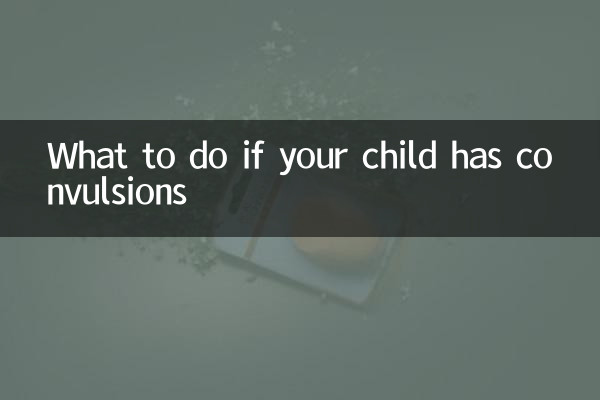What to do if your child has convulsions: First aid measures and prevention guide
Recently, among the hot topics about children's health, "how to deal with sudden convulsions in children" has become the focus of parents' attention. Convulsions are common in infants and children, and are mostly caused by high fever, epilepsy, or electrolyte imbalance. This article will provide you with structured data analysis and practical suggestions based on hot discussions across the Internet in the past 10 days.
1. Popularity data on topics related to childhood convulsions across the Internet in the past 10 days

| keywords | peak search volume | Main discussion platform |
|---|---|---|
| febrile convulsions | 82,000 times in a single day | Parenting forum, medical science account |
| Epilepsy first aid | 56,000 times in a single day | Short video platform, health public account |
| Children's calcium deficiency convulsions | 34,000 times in a single day | E-commerce platform Q&A area |
| Nocturnal convulsions | 28,000 times in a single day | Mother and baby community |
2. Analysis of common causes of convulsions
| Type | Proportion | Typical symptoms | High incidence age |
|---|---|---|---|
| febrile convulsions | 62% | General spasm when body temperature is >38.5°C | 6 months old-5 years old |
| epileptic seizure | 18% | Loss of consciousness, foaming at the mouth | all ages |
| electrolyte imbalance | 12% | local muscle twitching | 1-3 years old |
| other reasons | 8% | Various expressions | - |
3. First aid treatment steps (key content)
Step One: Ensure a Safe Environment
• Immediately remove surrounding sharp objects
• Lay the child flat on a soft surface
• Loosen the collar to allow for easy breathing
Step 2: Correct posture placement
• Lie on your side to prevent saliva from blocking the airway
• Tilt your head back to keep your neck stretched
•Never forcefully press down on a limb
Step 3: Record key information
• Twitch start and end times
• Specific manifestations (limb/facial tics, etc.)
• Is it accompanied by other symptoms such as fever?
4. Common mistakes that must be avoided
| Wrong approach | risk | correct alternative |
|---|---|---|
| pinch people | May cause soft tissue damage | Keep the environment quiet and wait for the attack to end |
| Stop foreign bodies and prevent tongue biting | Can cause suffocation or tooth damage | Just lie on your side |
| Force feeding medicine | Risk of coughing is extremely high | Give the drug after the attack is over |
5. Suggestions on preventive measures
1.High fever prevention:Use antipyretics promptly when the body temperature exceeds 38°C. For physical cooling, it is recommended to take a warm water bath instead of alcohol.
2.Nutritional supplements:Check blood calcium levels regularly. Children aged 1-3 years old need to consume 600-800mg of calcium daily.
3.Work and rest management:Ensure adequate sleep, preschool children should maintain 10-13 hours/day
4.Indications for medical treatment:In the following situations, you need to seek medical attention immediately:
• First attack
• Duration >5 minutes
• Recurrent attacks within 24 hours
• Confusion after seizure
6. Summary of latest opinions from experts
According to the recent live broadcast by pediatric experts from tertiary hospitals:
• 90% of febrile seizures have a good prognosis with no sequelae
• EEG is recommended to be performed 2 weeks after the attack to be more accurate
• New anti-epileptic drug topical gel enters clinical testing
This article combines real-time hotspot data and medical guidelines, and is recommended for parents to save for later use. You should learn basic first aid knowledge every day, but don't be overly anxious. Most children's convulsions are self-limiting. Staying calm and handling things correctly is key.

check the details

check the details